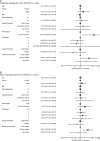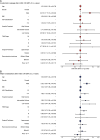Reconstruction Techniques and Associated Morbidity in Minimally Invasive Gastrectomy for Cancer: Insights From the GastroBenchmark and GASTRODATA databases
- PMID: 39101212
- PMCID: PMC11446507
- DOI: 10.1097/SLA.0000000000006470
Reconstruction Techniques and Associated Morbidity in Minimally Invasive Gastrectomy for Cancer: Insights From the GastroBenchmark and GASTRODATA databases
Abstract
Objective/background: Various anastomotic and reconstruction techniques are used for minimally invasive total (miTG) and distal gastrectomy (miDG). Their effects on postoperative morbidity have not been extensively studied.
Methods: MiTG and miDG patients were selected from 9356 oncological gastrectomies performed in 2017-2021 in 43 centers. Endpoints included anastomotic leakage (AL) rate and postoperative morbidity tested by multivariable analysis.
Results: Three major anastomotic techniques [circular stapled (CS); linear stapled (LS); and hand sewn (HS)], and 3 major bowel reconstruction types [Roux (RX); Billroth I (BI); Billroth II (BII)] were identified in miTG (n=878) and miDG (n=3334). Postoperative complications, including AL (5.2% vs 1.1%), overall (28.7% vs 16.3%), and major morbidity (15.7% vs 8.2%), as well as 90-day mortality (1.6% vs 0.5%) were higher after miTG compared with miDG. After miTG, the AL rate was higher after CS (4.3%) and HS (7.9%) compared with LS (3.4%). Similarly, major complications (LS: 9.7%, CS: 16.2%, and HS: 12.7%) were lowest after LS. Multivariate analysis confirmed anastomotic technique as a predictive factor for AL, overall, and major complications. In miDG, AL rate (BI: 1.4%, BII 0.8%, and RX 1.2%), overall (BI: 14.5%, BII: 15.0%, and RX: 18.7%), and major morbidity (BI: 7.9%, BII: 9.1%, and RX: 7.2%), and mortality (BI: 0%, BII: 0.1%, and RY: 1.1%%) were not affected by bowel reconstruction.
Conclusions: In oncologically suitable situations, miDG should be preferred to miTG, as postoperative morbidity is significantly lower. LS should be a preferred anastomotic technique for miTG in Western Centers. Conversely, bowel reconstruction in DG may be chosen according to the surgeon's preference.
Copyright © 2024 The Author(s). Published by Wolters Kluwer Health, Inc.
Conflict of interest statement
The authors report no conflicts of interest.
Figures


References
-
- Moehler M, Al-Batran S-E, Andus T, et al. . S3-Leitlinie Magenkarzinom–Diagnostik und Therapie der Adenokarzinome des Magens und des ösophagogastralen Übergangs–Langversion 2.0–August 2019. AWMF-Registernummer: 032/009OL. Zeitschrift für Gastroenterologie. 2019;57:1517–1632. - PubMed
-
- Lordick F, Carneiro F, Cascinu S, et al. . Gastric cancer: ESMO Clinical Practice Guideline for diagnosis, treatment and follow-up. Ann Oncol. 2022;33:1005–1020. - PubMed
-
- Ajani JA, D’Amico TA, Bentrem DJ, et al. . Gastric cancer, version 2.2022, NCCN clinical practice guidelines in oncology. J Natl Compr Canc Netw. 2022;20:167–192. - PubMed
Publication types
MeSH terms
LinkOut - more resources
Full Text Sources
Medical

